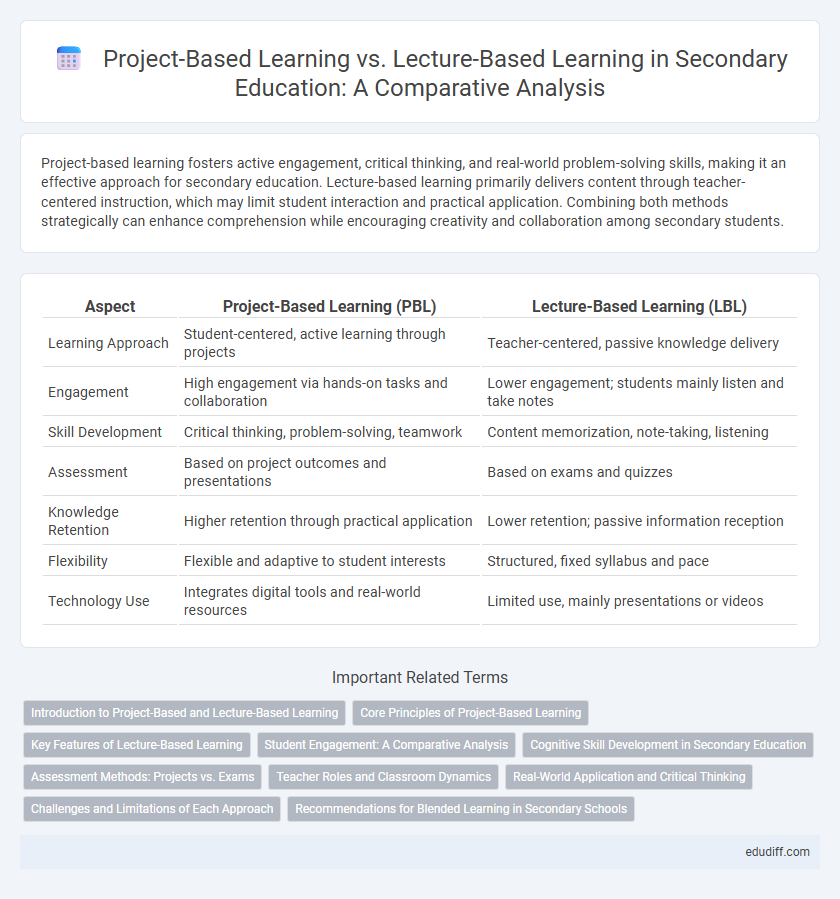Project-based learning fosters active engagement, critical thinking, and real-world problem-solving skills, making it an effective approach for secondary education. Lecture-based learning primarily delivers content through teacher-centered instruction, which may limit student interaction and practical application. Combining both methods strategically can enhance comprehension while encouraging creativity and collaboration among secondary students.
Table of Comparison
| Aspect | Project-Based Learning (PBL) | Lecture-Based Learning (LBL) |
|---|---|---|
| Learning Approach | Student-centered, active learning through projects | Teacher-centered, passive knowledge delivery |
| Engagement | High engagement via hands-on tasks and collaboration | Lower engagement; students mainly listen and take notes |
| Skill Development | Critical thinking, problem-solving, teamwork | Content memorization, note-taking, listening |
| Assessment | Based on project outcomes and presentations | Based on exams and quizzes |
| Knowledge Retention | Higher retention through practical application | Lower retention; passive information reception |
| Flexibility | Flexible and adaptive to student interests | Structured, fixed syllabus and pace |
| Technology Use | Integrates digital tools and real-world resources | Limited use, mainly presentations or videos |
Introduction to Project-Based and Lecture-Based Learning
Project-Based Learning (PBL) emphasizes student-centered inquiry by engaging learners in real-world projects that develop critical thinking, collaboration, and problem-solving skills. In contrast, Lecture-Based Learning relies on instructor-led presentations to deliver content, often prioritizing information transmission over active participation. Both approaches serve educational purposes, but PBL fosters deeper understanding and practical application in secondary education settings.
Core Principles of Project-Based Learning
Project-Based Learning (PBL) centers on student-driven inquiry, real-world problem solving, and collaborative teamwork to deepen understanding and foster critical thinking. It emphasizes autonomy, sustained investigation, and iterative reflection, contrasting sharply with Lecture-Based Learning's focus on passive information delivery and memorization. Core principles of PBL include meaningful context, student agency, authentic assessment, and integration of interdisciplinary knowledge to prepare learners for complex challenges.
Key Features of Lecture-Based Learning
Lecture-Based Learning involves a teacher-centered approach where information is delivered through structured presentations and note-taking. It emphasizes passive absorption of content, clear organization of material, and efficient coverage of a broad curriculum in limited time. This method facilitates standardized assessment but may limit student engagement and critical thinking development.
Student Engagement: A Comparative Analysis
Project-Based Learning (PBL) significantly enhances student engagement by promoting active participation, critical thinking, and collaboration, which are less emphasized in traditional Lecture-Based Learning (LBL). Research indicates that PBL increases motivation and knowledge retention through real-world problem solving, whereas LBL often results in passive learning and lower interaction levels. Metrics from multiple studies reveal that students in PBL environments demonstrate higher attendance rates, greater enthusiasm in class discussions, and improved academic outcomes compared to those in LBL settings.
Cognitive Skill Development in Secondary Education
Project-based learning in secondary education significantly enhances cognitive skill development by fostering critical thinking, problem-solving, and creativity through hands-on, real-world applications. Lecture-based learning predominantly promotes knowledge retention and comprehension but may limit opportunities for analytical reasoning and active engagement. Research indicates students engaged in project-based approaches demonstrate higher-order thinking skills and better adaptability to complex tasks compared to those in traditional lecture settings.
Assessment Methods: Projects vs. Exams
Project-based learning employs continuous assessment through real-world tasks, emphasizing critical thinking and practical application of knowledge. Lecture-based learning primarily relies on exams that test memorization and theoretical understanding under timed conditions. Project assessments foster collaboration and problem-solving skills, while exams gauge individual retention and standardized knowledge evaluation.
Teacher Roles and Classroom Dynamics
In Project-Based Learning, teachers serve as facilitators who guide students through inquiry and collaboration, fostering active engagement and critical thinking. Classroom dynamics shift towards student-centered interactions, with increased peer cooperation and hands-on problem solving. In contrast, Lecture-Based Learning positions teachers as primary knowledge transmitters, resulting in a more passive, teacher-led classroom environment with limited student participation.
Real-World Application and Critical Thinking
Project-Based Learning (PBL) enhances real-world application by engaging students in hands-on tasks that mirror authentic challenges, promoting deeper understanding and retention. This approach stimulates critical thinking as learners analyze, evaluate, and create solutions within relevant contexts, contrasting with lecture-based learning's passive information absorption. Studies show PBL improves problem-solving skills and prepares students for complex, real-life scenarios in secondary education settings.
Challenges and Limitations of Each Approach
Project-based learning faces challenges such as resource intensiveness, time constraints, and the need for skilled facilitators to guide complex tasks, which can hinder implementation in traditional secondary classrooms. Lecture-based learning often limits student engagement and critical thinking, relies heavily on rote memorization, and may fail to address diverse learning styles, reducing its overall effectiveness. Both approaches require strategic integration and adaptation to balance active participation with structured knowledge delivery in secondary education settings.
Recommendations for Blended Learning in Secondary Schools
Blended learning in secondary schools combines project-based learning's hands-on engagement with lecture-based learning's structured content delivery to enhance student comprehension and critical thinking skills. Integrating digital tools facilitates personalized pacing and collaboration, optimizing both independent inquiry and guided instruction. Schools should provide professional development for teachers to effectively balance these methods, ensuring curriculum alignment and technology integration support diverse learning styles.
Project-Based Learning vs Lecture-Based Learning Infographic

 edudiff.com
edudiff.com